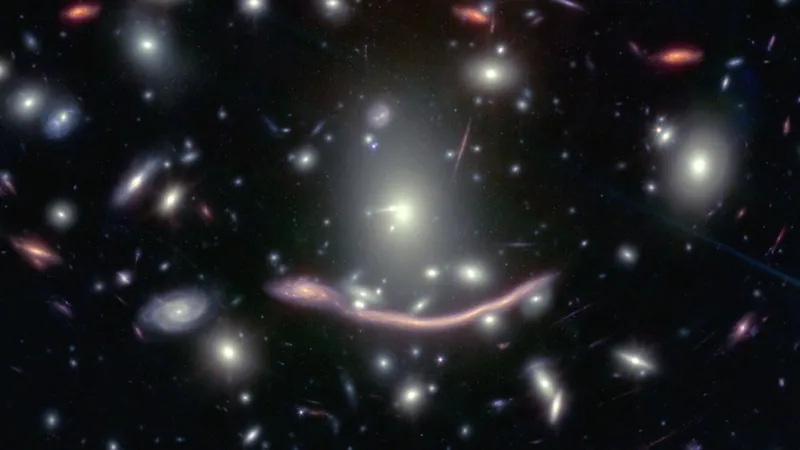
Unveiling the Cosmic Treasure: James Webb Telescope Discovers Unprecedented Cache of Stars in the Mysterious Dragon Galaxy!
2025-01-07
Author: Ming
Groundbreaking Discovery by the James Webb Space Telescope
Astronomers utilizing the advanced capabilities of the James Webb Space Telescope (JWST) have made a groundbreaking discovery, uncovering a staggering number of ancient stars hidden within a distant galaxy known as the Dragon Arc. This remarkable find marks the largest collection of individually imaged stars ever observed at such vast distances—about 6.5 billion light-years from Earth.
The Dragon Arc Galaxy
The Dragon Arc is a spiral galaxy observed during a time when the universe was merely half its current age, providing a unique glimpse into our cosmic past. Typically, distant stars are too faint for detailed observation, but gravitational lensing—the phenomenon predicted by Einstein's theory of general relativity—has changed the game. This occurs when light from far-off objects is bent and magnified by the gravity of a massive object, such as a galaxy cluster, situated between the light source and the observer.
The Role of Gravitational Lensing
In this instance, the gravity of Abell 370, a galaxy cluster located roughly 4 billion light-years away, has distorted and magnified the light from the Dragon Arc, creating striking arcs of illuminated celestial body. Researchers, intrigued by the potential to find new celestial phenomena, became pleasantly surprised when they discovered not just galaxies but 44 individual stars in their observations.
Researcher Insights
"When we began our research, our primary focus was on uncovering a background galaxy lensed by the gravity of the massive cluster," explains Fengwu Sun, a postdoctoral researcher at the Harvard and Smithsonian Center for Astrophysics. "To our astonishment, our analysis revealed what appeared to be numerous individual star points."
A Significant Advancement
This discovery marks a remarkable advance in the field. Previously, the most extensive groups of individually imaged stars beyond our closest neighboring galaxies like Andromeda consisted of only seven stars. Sun notes, “This groundbreaking revelation demonstrates for the first time that it is possible to study large numbers of individual stars in a distant galaxy.”
Revolutionary Technology
JWST's powerful infrared sensors have revolutionized our ability to observe and interpret the light from distant stars, making them appear clearer and allowing scientists to delve into their characteristics. Among the 44 newly identified stars, the majority are classified as red supergiants—immense luminous beacons that dwarf our own sun.
Implications of the Findings
By analyzing these ancient stars, researchers aim to gain deeper insights into the evolutionary path of similar stars within our Milky Way galaxy. The implications of this research are vast, potentially unveiling secrets about galaxy formation and the enduring enigma of dark matter that cloaks our universe.
Looking Forward
The team is now poised for further exploration, continuing their quest to unveil more stars in the warped light of the Dragon Arc and other distant galaxies. The findings of this study not only advance our understanding of stellar evolution but also promise to unravel some of the most profound questions about the cosmos. The universe still holds countless mysteries waiting to be discovered—what will the JWST reveal next? Stay tuned!
 Brasil (PT)
Brasil (PT)
 Canada (EN)
Canada (EN)
 Chile (ES)
Chile (ES)
 Česko (CS)
Česko (CS)
 대한민국 (KO)
대한민국 (KO)
 España (ES)
España (ES)
 France (FR)
France (FR)
 Hong Kong (EN)
Hong Kong (EN)
 Italia (IT)
Italia (IT)
 日本 (JA)
日本 (JA)
 Magyarország (HU)
Magyarország (HU)
 Norge (NO)
Norge (NO)
 Polska (PL)
Polska (PL)
 Schweiz (DE)
Schweiz (DE)
 Singapore (EN)
Singapore (EN)
 Sverige (SV)
Sverige (SV)
 Suomi (FI)
Suomi (FI)
 Türkiye (TR)
Türkiye (TR)
 الإمارات العربية المتحدة (AR)
الإمارات العربية المتحدة (AR)